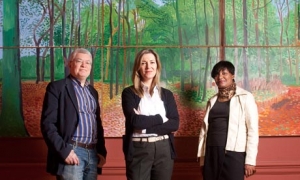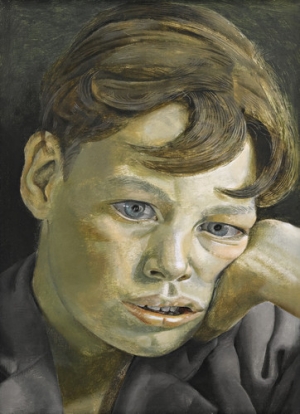|
Displaying items by tag: Freud

David Hockney: Royal Academy
It's an Olympic year for artists too, and first out of the blocks is David Hockney: A Bigger Picture at the Royal Academy. Like the athletes competing in London this summer, Hockney – now a veteran at 74 – has spent the past four years pushing himself beyond his limits in preparation for what could be the defining test of his career. The result is one of the most ambitious shows in the Academy's 244-year history: more than 150 works, some of them gargantuan, more than 80% of which have been made specially for this exhibition and the particular spaces of this light-filled gallery.
For Edith Devaney, co-curator of the exhibition, the most invigorating part of the process has been watching the new paintings emerge first-hand. "Like David, we didn't know what to expect, but we knew it would be exciting," she says. "I remember him saying to me when we started off this process, 'We won't get this wrong.' And I thought, 'No, we won't.'"
Hockney has always dabbled in landscapes – notably his photo collages of the Grand Canyon and Pearblossom Highway in the 1980s and 90s when he was still in the States – but they have been a sustained focus of his work since he returned to live in Bridlington, East Yorkshire a decade ago. In recent years he has produced paintings at a complusive rate, first with watercolours then oils, and most recently on his iPhone and iPad. "David's not actually that interested in technology, he's just interested in other methods you can use to make art," she explains. "The work he did on his iPhone is charming, but the work he does on his iPad has the painterly quality of his oils – it's astonishing."
Another new direction for Hockney is his use of film. Showing as a world exclusive at the Royal Academy his films are created by nine high-definition cameras pointing in fractionally different directions – the result has been described as a "moving cubist collage".
"It has the same multiplicity of perspectives," says Devaney. "When you look at this film you feel as though you are seeing the world through David Hockney's eyes."
With Hockney's canny knack for self-promotion – he recently declined to paint the Queen because he was "very busy painting England actually, her country" – marketing expectations for the show are off the scale. As a private and independent institution, the Royal Academy is not obliged to supply a projected attendance, but there are whispers that A Bigger Picture could challenge the 1999 Monet exhibition, which hosted 813,000 visitors. Demand was so relentless back then that the Academy opened its doors 24 hours a day, a UK first. "In principle we'd do that again," says Jennifer Francis, head of press and marketing. "Certainly in the final few weeks, if we think people will be there at three in the morning."
Advertising for the show will have local, national and international targets – from buses in Bradford to the LA tourist board. "It's the first time I've bought space on buses up and down the country," says Francis. "There is a massive buzz about this exhibition."

Three champion British artists line up in London for a grand parade of exhibitions at the start of Olympic year. First out is David Hockney, whose “A Bigger Picture” (Jan. 21-April 9, 2012) will fill the main galleries of the Royal Academy almost entirely with new pictures.
In recent years, Hockney has been hard at work in a quiet corner of East Yorkshire. When asked to paint a portrait of the Queen, he replied that unfortunately he was, “very busy painting England actually, her country.”
He has not only been painting it, he has been drawing it on his iPad and experimenting with a hi-tech medium consisting of high-definition images taken by nine cameras pointing in slightly differing directions. The results, a sort of moving Cubist collage, will be unveiled to the world at the exhibition. The RA recommends booking in advance for this exhibition. Rumor has it that the projected attendance may exceed the previous record at the venue held by one of Hockney’s idols, Claude Monet.
Hockney wasn’t too busy to spend time a decade ago sitting for a portrait by his friend Lucian Freud. The exhibition “Lucian Freud Portraits” (Feb. 9-May 27) at the National Portrait Gallery is the first major showing of the artist’s work since his death last July. The restriction of the title is in reality not much of a limitation since to Freud a picture of just about anything was a portrait, certainly a depiction of a person wearing no clothes (to him, “a naked portrait”).
Personal Portrait
Had Freud lived, this exhibition would have marked his 90th birthday year. As it is, it will be the first opportunity since 2002 to see a retrospective in London of work by a painter who increasingly looks not only like one of the great U.K. artists, but among the most important painters of the past 50 years anywhere. I must, however, declare an interest, since one of the portraits is of me. I’m looking forward to seeing myself for the first time in some years.
Third contestant in this artistic triathlon is Damien Hirst, the first big museum retrospective of whose art will be at Tate Modern (April 4-Sept. 9). Included will be many celebrated -- or notorious, depending on your point of view -- pieces, among them “The Physical Impossibility of Death in the Mind of Someone Living” (1991) otherwise known as Hirst’s shark. In the Turbine Hall, meanwhile, will be the sinister yet sparkling “For the Love of God” (2007), the diamond-encrusted platinum skull which, even though there is controversy as to whether the original 50 million pound ($78.5 million) asking price was ever paid, must be the most costly memento mori in art history.

Lucian Freud and Alberto Burri paintings sold for $5 million each in London last night at a Sotheby’s auction overshadowed by concern about market weakness and a protest by U.S. art handlers over a labor dispute.
Bidders had to pass a group of 20 chanting and whistling demonstrators, including three who had flown from New York and promised more action. While the contemporary and 20th-century Italian sale set six artist records and raised 40 million pounds ($63 million), the top presale estimate at hammer prices was 48.3 million pounds. Some paintings went unsold, such as Peter Doig’s “Bellevarde,” valued at as much as 2 million pounds.
“That would have sold a year ago,” the London-based dealer Edmondo di Robilant said. “The mood has changed. Auction houses entice things with high estimates and in the past they’ve been able to sell them. That wasn’t always the case tonight. A number of lots that sold were knocked down against lowered reserves.”
Dealers said economic worries were weighing on some buyers. Even headline-grabbing pieces such as Marc Quinn’s 18-carat gold sculpture of Kate Moss in a yoga pose attracted just one bid. The 2008 “Microcosmos (SIREN)” was knocked down to a bidder represented by Patti Wong of Sotheby’s Asia for 577,250 pounds.
There was also just one telephone bid for the 1952 close-up portrait “Boy’s Head” by Freud, who died in July, aged 88. It was valued at 3 million pounds and fetched 3.2 million pounds.
With buyers spoiled for choice by the $500 million of art on sale in the U.K. this week, 23 percent of the contemporary lots went unsold. The preceding Italian component was more enthusiastically received.

Works by Francis Bacon, Peter Doig and Lucian Freud helped Christie’s International raise 78.8 million pounds ($126 million) at an auction in London last night. It was the company’s highest total for a sale of contemporary works in the U.K. capital since June 2008.
The top seller was Bacon’s “Study for a Portrait,” a precursor of the Irish-born artist’s “Pope” paintings, offered by the Swiss entrepreneur and collector Donald M. Hess. The painting sold to a telephone bidder represented by Christie’s specialist Sandra Nedvetskaia, who deals with Russian clients, for 18 million pounds, against two other telephone bidders. The 1953 work was estimated at about 11 million pounds.
The above-estimate price contrasted with the failure of Bacon’s similar 1954 painting, “Man in Blue VI,” estimated at 4 million pounds to 5 million pounds, at Christie’s in February 2009 during the financial crisis.
“Bacon is back,” Offer Waterman, a London-based dealer, said. “The market is strong, though with problems like Greece, it could fall out of bed in two minutes. At the moment, there are people with plenty of cash who are investing in art as an asset class.”
Christie’s 65-lot offering had carried an estimate of 55.3 million pounds to 76.8 million pounds and was part of a series of evening sales in London that is estimated to raise as much as 195 million pounds, reflecting renewed confidence among sellers of high-value contemporary works.
While the mood in the market was lifted by dealers reporting plentiful sales in the $200,000 to $2 million-range earlier this month at the Art Basel fair in Switzerland, auctions remain the arena where international collectors are most prepared to spend multimillion sums.
Doig’s Surprise
The surprise of the evening was the 6.2 million pounds paid by another telephone bidder, represented by Christie’s U.K. chairman David Linley, for Doig’s 2003 to 2004 West Indian landscape, “Red Boat” (Imaginary Boys),” estimated at 1.4 million pounds to 1.8 million pounds.
Another telephone bidder, competing against a third-party guarantor, gave 7 million pounds for Andy Warhol’s 1973 silkscreen painting, “Mao,” a work estimated at 6 million pounds to 8 million pounds.
A 1958-1959 Freud portrait of his lover Suzy Boyt sold for 4.7 million pounds against an estimate of 3.5 million pounds to 4.5 million pounds. Entered by a descendant of the late Simon Sainsbury, “Woman Smiling” was bought by a telephone bidder.
|
|
|
|
|